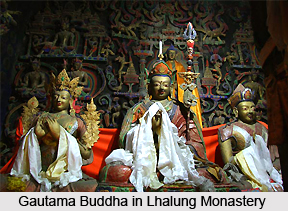 Also known as the Golden Temple, Lhalung Monastery is situated in Lahaul and Spiti district of Himachal Pradesh and it is one of the earliest monasteries founded in Spiti District of Himachal Pradesh. Lhalung Monastery was constructed by the great Tibetan Buddhist translator, Rinchen Zangpo, the king of western Himalayan Kingdom of Guge (Kadampa Dynasty) during the late 10th century AD. The altitude of the neighbouring village of Lhalun Monastery is 3,658 metres. The monastery is considered an ancient centre of learning and debate.
Also known as the Golden Temple, Lhalung Monastery is situated in Lahaul and Spiti district of Himachal Pradesh and it is one of the earliest monasteries founded in Spiti District of Himachal Pradesh. Lhalung Monastery was constructed by the great Tibetan Buddhist translator, Rinchen Zangpo, the king of western Himalayan Kingdom of Guge (Kadampa Dynasty) during the late 10th century AD. The altitude of the neighbouring village of Lhalun Monastery is 3,658 metres. The monastery is considered an ancient centre of learning and debate.
The monastery is also known as Golden Temple because of various gold leaf deities kept in its holy place. The place of worship is known as Serkhang and it is a beautiful chamber with beautifully decorated walls of studded images of more than 50 deities. The village near Lhalung Monastery has 45 homes is 14 km from the main road and is the largest in the Lingti valley. At some places remains of an ancient wall encircling all the monastery buildings may be found.
History of the Lhalung Monastery
The name of Lhalung Monastery is derieved from "Lhalun" literally means `land of the gods`. It is said that the Lhalung Devta is head of all the local gods and goddess of the valley and emerges from the Tangmar Mountain beyond the village. This mountain is said to change colour depending on the moods of the devtas or deities; red showing anger, yellow, happiness, etc. The temple is believed to have been constructed overnight by the gods after Lotsava Rinchen Zangpo planted a willow tree here, promising that if it lived through the year, and a temple would be built next to it, the tree still stands outside the Gompa to this day.
Architecture of the Lhalung Monastery
The Lhalung monastery buildings are enclosed by historical object walls and it is the largest settlement which is found in the Lingti Valley. At a particular time, the round passage for ambulation around the inner workroom was decorated with beautiful paintings but presently these pictures have become dull and there is a tree which is perhaps related with the monastery formerly inside this monastery.
A white shrine is present where four images of Buddha facing towards the four key directions have been constructed just outside of the main Gompa. It is believed that these images are as old as the monastery. A lot of Buddhist remnants and pattern associated with Buddhist customs can been found in the Gompa.
Attractions of the Lhalung Monastery
The monastery has huge collection of 101 Buddhist scriptures, of the "Kangyur" which is Buddha`s own teachings in their Tibetan translation has been stored in the library which attracts the number of tourists. The library also has "Thangkas" which depicts the life of Buddha. There are 108 main wheels in the monastery, which keeps self-turning on auspicious occasions and is another attraction of the monastery.
Connectivity of the Lhalung Monastery
Flight services are available till Bhunter airport to reach Spiti and from there it"s a 165 km journey. Taxi and bus services are available from Bhunter.
Another option is to take bus or taxi from Shimla via Kinnaur to Kaza. The route from Shimla to Kaza is about 412 km long and remains open from May to October and hiring taxi from Chandigarh is also a good option to reach Spiti.






